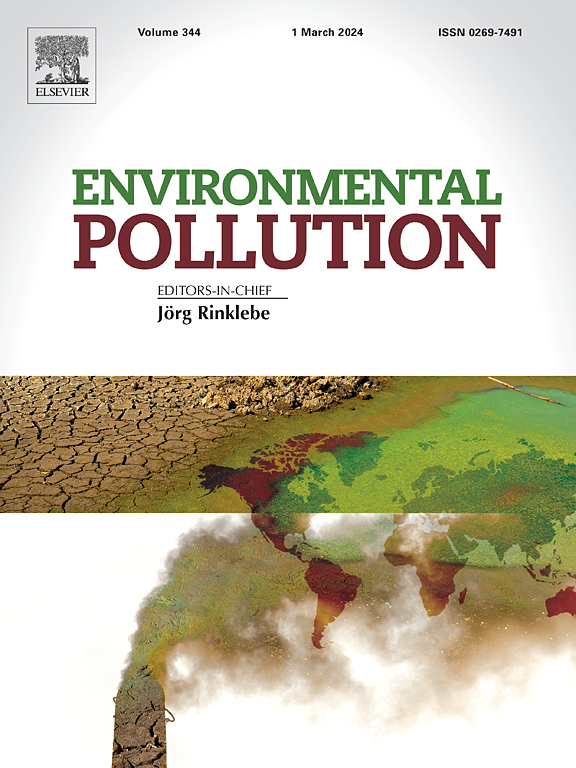Multi-specific assessment of microplastic ingestion by Antarctic fish from the Ross Sea (Southern Ocean)
IF 7.6
2区 环境科学与生态学
Q1 ENVIRONMENTAL SCIENCES
引用次数: 0
Abstract
Microplastics contaminate all places on Earth, including remote areas such as polar regions. To date, our knowledge on the impact of synthetic materials on the Antarctic ecosystems is still very limited. To the best of our knowledge and considering the number of individuals analyzed, this study provides the largest assessment currently available of microplastic ingestion by Antarctic fish, including the first evidence of microplastics occurrence in Chionodraco hamatus, Pagothenia borchgrevinki, and Trematomus newnesi. The analysis of 145 samples of seven different species from the Ross Sea (Southern Ocean) reveals diffuse contamination in three important locations such as Tethys Bay, Silverfish Bay, and Inexpressible Island. The overall frequency of microplastic ingestion (32.4 % of individuals examined) is similar to the averages estimated for non-polar marine environments on a global scale. In contrast, the average ± se number of microplastics per individual (0.53 ± 0.04) results to be lower. Differences in habitat use and feeding habits appear to underlie the different ingestion rates across species, with cryopelagic planktivores and demersal piscivores being more exposed to microplastics than benthopelagic planktivores and demersal benthivores. Furthermore, the microplastic ingestion rates detected in white-blooded species are higher than those found in red-blooded species. This evidence suggests that the physiology of these organisms may alter the detection of microplastic ingestion events, indicating that the low metabolic rates that characterize species lacking hemoglobin could determine an increase in the retention time of microplastics in internal organs, raising concern for the possible impacts of these contaminants on cold-adapted species.


罗斯海(南大洋)南极鱼类摄入微塑料的多特异性评估
微塑料污染了地球上的所有地方,包括极地等偏远地区。迄今为止,我们对合成材料对南极生态系统的影响的了解仍然非常有限。据我们所知,考虑到所分析的个体数量,这项研究提供了目前南极鱼类摄入微塑料的最大评估,包括在Chionodraco hamatus, Pagothenia borchgrevinki和Trematomus newnesi中出现微塑料的第一个证据。对来自罗斯海(南大洋)的7个不同物种的145个样本的分析表明,在特提斯湾、银鱼湾和不可表达岛等三个重要地点存在广泛的污染。微塑料摄入的总体频率(被检查个体的32.4%)与全球范围内非极地海洋环境的平均估计相似。相比之下,个体微塑料的平均±se数(0.53±0.04)较低。栖息地利用和摄食习惯的差异似乎是不同物种摄食率的基础,与底栖浮游动物和底栖底栖动物相比,低温浮游动物和底栖鱼栖动物更容易接触到微塑料。此外,在白血物种中检测到的微塑料摄入率高于红血物种。这一证据表明,这些生物的生理可能会改变对微塑料摄入事件的检测,表明缺乏血红蛋白的物种的低代谢率可能决定了微塑料在内脏中停留时间的增加,这引起了人们对这些污染物对冷适应物种可能产生影响的关注。
本文章由计算机程序翻译,如有差异,请以英文原文为准。
求助全文
约1分钟内获得全文
求助全文
来源期刊

Environmental Pollution
环境科学-环境科学
CiteScore
16.00
自引率
6.70%
发文量
2082
审稿时长
2.9 months
期刊介绍:
Environmental Pollution is an international peer-reviewed journal that publishes high-quality research papers and review articles covering all aspects of environmental pollution and its impacts on ecosystems and human health.
Subject areas include, but are not limited to:
• Sources and occurrences of pollutants that are clearly defined and measured in environmental compartments, food and food-related items, and human bodies;
• Interlinks between contaminant exposure and biological, ecological, and human health effects, including those of climate change;
• Contaminants of emerging concerns (including but not limited to antibiotic resistant microorganisms or genes, microplastics/nanoplastics, electronic wastes, light, and noise) and/or their biological, ecological, or human health effects;
• Laboratory and field studies on the remediation/mitigation of environmental pollution via new techniques and with clear links to biological, ecological, or human health effects;
• Modeling of pollution processes, patterns, or trends that is of clear environmental and/or human health interest;
• New techniques that measure and examine environmental occurrences, transport, behavior, and effects of pollutants within the environment or the laboratory, provided that they can be clearly used to address problems within regional or global environmental compartments.
 求助内容:
求助内容: 应助结果提醒方式:
应助结果提醒方式:


